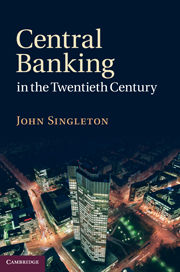Book contents
- Frontmatter
- Contents
- List of illustrations
- Acknowledgements
- List of abbreviations
- 1 A beginner's guide to central banking
- 2 Very boring guys?
- 3 Wind in the willows: the small world of central banking c. 1900
- 4 Something for everyone: new central banks, 1900–1939
- 5 A series of disasters: central banking, 1914–1939
- 6 The mysteries of central bank cooperation
- 7 The first central banking revolution
- 8 No time for cosmic thinkers: Central banking in the ‘Keynesian’ era
- 9 Rekindling central bank cooperation in the Bretton Woods era
- 10 The goose that lays the golden egg: Central banking in developing countries
- 11 The horse of inflation
- 12 The second central banking revolution: Independence and accountability
- 13 Reputations at stake: financial deregulation and instability
- 14 Inflation targeting: the holy grail?
- 15 The long march to European monetary integration
- 16 A world with half a million central bankers
- References
- Index
9 - Rekindling central bank cooperation in the Bretton Woods era
Published online by Cambridge University Press: 04 February 2011
- Frontmatter
- Contents
- List of illustrations
- Acknowledgements
- List of abbreviations
- 1 A beginner's guide to central banking
- 2 Very boring guys?
- 3 Wind in the willows: the small world of central banking c. 1900
- 4 Something for everyone: new central banks, 1900–1939
- 5 A series of disasters: central banking, 1914–1939
- 6 The mysteries of central bank cooperation
- 7 The first central banking revolution
- 8 No time for cosmic thinkers: Central banking in the ‘Keynesian’ era
- 9 Rekindling central bank cooperation in the Bretton Woods era
- 10 The goose that lays the golden egg: Central banking in developing countries
- 11 The horse of inflation
- 12 The second central banking revolution: Independence and accountability
- 13 Reputations at stake: financial deregulation and instability
- 14 Inflation targeting: the holy grail?
- 15 The long march to European monetary integration
- 16 A world with half a million central bankers
- References
- Index
Summary
The United Nations Monetary and Financial Conference recommends the liquidation of the Bank for International Settlements at the earliest possible moment.
Resolution V of the Final Act of the Bretton Woods Conference, 1944 (quoted in Baer 1999: 361)The September 1960 annual meeting of the IMF registered concern about the dollar's exchange rate. Kennedy's election, two months later, did little to reassure markets. It is in this context that the United States ‘re-discovered’ the BIS.
Claudio Borio and Gianni Toniolo (2008: 45)The international connections and activities of central banks aroused considerable suspicion during the 1940s, not least amongst some of the framers of the Bretton Woods settlement. Special hostility was reserved for the Bank for International Settlements, which had been tainted by its pre-war enthusiasm for the gold standard, and by the perception that it was a collaborator of the Axis powers. The Bretton Woods agreements were intergovernmental, and central banks were assigned a largely subordinate, technical role in their functioning. Between 1945 and the end of the Bretton Woods exchange rate system in the early 1970s, however, central banks and the BIS fought to rebuild their influence in the international arena. Their success, though not immediate, owed much to the shortcomings of Bretton Woods and its principal agent, the International Monetary Fund (IMF). By the 1970s, central banks were well on their way to regaining the status that they had lost in the 1930s and 1940s.
- Type
- Chapter
- Information
- Central Banking in the Twentieth Century , pp. 147 - 164Publisher: Cambridge University PressPrint publication year: 2010

